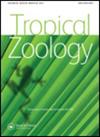Diurnal activity patterns and feeding ecology of geladas (Theropithecus gelada) in Ankober District at Kundi, North Shewa, Ethiopia
IF 0.7
4区 生物学
Q4 ZOOLOGY
引用次数: 2
Abstract
Theropithecus gelada is the primate species endemic to the central and northwestern highlands of Ethiopia and is the only extant species of the genus Theropithecus. Diurnal activity patterns and feeding behavior of geladas were studied at Kundi, Ankober district, Ethiopia from August 2017 to March 2018 to cover both wet and dry seasons. Scan sampling method was employed to study the activity patterns and feeding behavior of geladas in the study area. Activity scans were collected at 15-minutes intervals for up to 5 minutes duration from 0700 to 1730h. During each scan, individuals were recorded as performing one of the following behaviors: feeding, moving, resting, playing, aggression, grooming, sexual activity and others. Descriptive statistics and Chi-square test were used in data analysis. During the wet season geladas spent grooming 20%, playing 19%, 14% resting, feeding 12%, other activity 11%, moving 9% and 3% in aggression. Geladas spent 27% feeding, 21% moving, 13% other activities, 12% aggression, 7% grooming, 7% playing and 4% resting during the dry season. There were significant differences in all activity time budgets between seasons except other activities. The total time spent feeding on grass blades and cereals were 25.5% and 23.5% in the study area, respectively. There was a significant difference between the age and sex classes of geladas in their activity time budgets. Eleven species of plants were recorded as the food of geladas in this study area. This study provides baseline information on the behavioral ecology of geladas outside protected areas.埃塞俄比亚北谢瓦昆迪Ankober地区狒狒(Theropithecus gelada)的日活动模式和摄食生态
狮尾羚是埃塞俄比亚中部和西北部高地特有的灵长类物种,是狮尾羚属中唯一现存的物种。2017年8月至2018年3月,在埃塞俄比亚安科贝尔地区的昆迪,研究了狒狒的昼夜活动模式和摄食行为,涵盖了旱季和雨季。采用扫描取样法对研究区狒狒的活动模式和摄食行为进行了研究。从0700到1730,每隔15分钟收集一次活动扫描,持续时间长达5分钟。在每次扫描过程中,个体被记录为以下行为之一:进食、移动、休息、玩耍、攻击、梳理、性活动和其他行为。资料分析采用描述性统计和卡方检验。在潮湿的季节,狒狒的梳洗时间占20%,玩耍时间占19%,休息时间占14%,进食时间占12%,其他活动占11%,移动时间占9%,攻击时间占3%。在旱季,狒狒27%的时间用于觅食,21%的时间用于移动,13%的时间用于其他活动,12%的时间用于攻击,7%的时间用于梳理毛发,7%的时间用于玩耍,4%的时间用于休息。除其他活动外,所有活动时间预算在季节之间均存在显著差异。研究区草叶和谷物的取食时间分别为25.5%和23.5%。不同年龄和性别的狒狒在活动时间预算上存在显著差异。研究区记录到狒狒的食物植物有11种。本研究提供了保护区外狒狒行为生态学的基线信息。
本文章由计算机程序翻译,如有差异,请以英文原文为准。
求助全文
约1分钟内获得全文
求助全文
来源期刊

Tropical Zoology
生物-动物学
CiteScore
2.50
自引率
0.00%
发文量
1
审稿时长
>12 weeks
期刊介绍:
Tropical Zoology is an international zoological journal publishing original papers in the field of systematics, biogeography, phylogeny, ecology and conservation of all terrestrial and aquatic animal Phyla from tropical and subtropical areas.
Only papers with new information, high quality and broad interest are considered. Single species description and checklists are not normally accepted. Review papers are welcome. The journal is owned by the Istituto di Ricerca sugli Ecosistemi Terrestri of the Consiglio Nazionale delle Ricerche, Florence, Italy (CNR-IRET) who performs research into the structure and functioning of aquatic and terrestrial ecosystems, focusing in particular on anthropogenic pressure and global change. The knowledge amassed forms the scientific basis for identifying the most appropriate protective and corrective interventions, and provides support for the bodies entrusted with formulating policies for environmental protection and recovery.
 求助内容:
求助内容: 应助结果提醒方式:
应助结果提醒方式:


